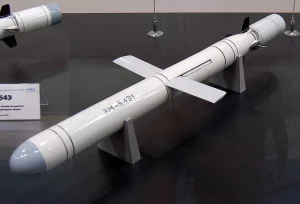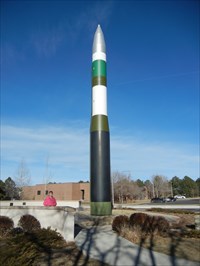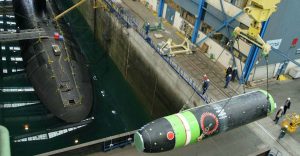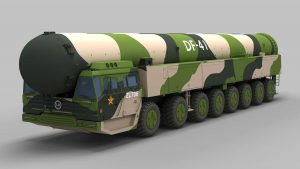Countries all over the world are known to engage in wars back in the years. Our ancestors used improvised makeshift weapons from trees and rocks mainly for warfare, hunting, and self-defense. We are mainly territorial, and in order to protect the tribe, building defenses is vital. In the present day, technology has a huge impact on the modernization of military equipment such as guns, aircraft, and missiles. In comparison to manned aircraft and short-range guns, missiles have fewer maintenance, training, and logistical requirements. Because missiles can be loaded with chemical, biological, or nuclear payloads, even limited use of these weapons might be disastrous.
Here are the 11 most powerful missiles in the world.
- BGM-71 TOW 2B
 This latest version flies over a tank and launches projectiles at it, piercing the tank’s top armor. The previous versions were wired, however, the most recent version is wireless. The TOW can be launched from any ground vehicle. This is the name given to the basic missile system that has been in use by the American military since 1970. TOW stands for tube has been launched, optically monitored and wire-assisted. In September 2017, Raytheon received orders worth more than half a billion dollars to construct these wireless, radio-controlled anti-armor weapons, which are currently employed by more than 40 armed forces around the world.
This latest version flies over a tank and launches projectiles at it, piercing the tank’s top armor. The previous versions were wired, however, the most recent version is wireless. The TOW can be launched from any ground vehicle. This is the name given to the basic missile system that has been in use by the American military since 1970. TOW stands for tube has been launched, optically monitored and wire-assisted. In September 2017, Raytheon received orders worth more than half a billion dollars to construct these wireless, radio-controlled anti-armor weapons, which are currently employed by more than 40 armed forces around the world.
2. DF-31AG mobile intercontinental ballistic missile
 This is China’s most recent improvement to the DF-31A, which was introduced in 2009. The main change is that this version of the missile can carry several warheads, which boasts China’s capacity to defeat US missile defenses. In July 2017, it was on display as part of the People’s Liberation Army’s 90th Anniversary Parade.
This is China’s most recent improvement to the DF-31A, which was introduced in 2009. The main change is that this version of the missile can carry several warheads, which boasts China’s capacity to defeat US missile defenses. In July 2017, it was on display as part of the People’s Liberation Army’s 90th Anniversary Parade.
3. Tomahawk Cruise Missile

Three-quarter left front view of Tomahawk Cruise Missile (flight test version) on display in the Mall Building, National Air and Space Museum, Smithsonian Institution
In 1984, the Tomahawk was first deployed. It was called after the Native American ax. It’s a long-range subsonic cruise missile meant to hit land targets that are either well protected or of great value. It has a top speed of roughly 550 mph and a range of nearly 1,500 miles. Using guidance systems adapted to specific missions, the missile can be guided to take evasive courses. The Tomahawk Land Attack Missile, or TLAM, is its official name. Both US and UK submarines, as well as US Navy surface ships, have successfully launched it. The Tomahawk comes in a variety of variations, each with its own set of features. The latest models may be reprogrammed in flight using satellite communications to program alternate targets or reroute using GPS coordinates. It carries a nuclear warhead as well as extra bomblets, depending on the variant.
4. SS-N-30
 On October 7, 2017, Russian warships launched 26 cruise missiles. They were dispatched to Syrian opposition targets 1,000 kilometers away from the Caspian Sea warships. Even those who keep a frequent, well-trained eye on Russian and its military were surprised by these almost unknown missiles, according to the Pentagon. The attack is being interpreted as a sign to the rest of the world that Russia’s new missiles have established themselves as among the most advanced in the world. The missiles hit 11 targets, including a terrorist training camp, command centers, armament, oil, and munitions storage, and ammunition and explosives manufacturing sites, completing their mission. Though exact figures are obviously unknown, the missiles indicated that they are equivalent to the Tomahawk missiles that Great Britain and the United States have successfully employed in combat.
On October 7, 2017, Russian warships launched 26 cruise missiles. They were dispatched to Syrian opposition targets 1,000 kilometers away from the Caspian Sea warships. Even those who keep a frequent, well-trained eye on Russian and its military were surprised by these almost unknown missiles, according to the Pentagon. The attack is being interpreted as a sign to the rest of the world that Russia’s new missiles have established themselves as among the most advanced in the world. The missiles hit 11 targets, including a terrorist training camp, command centers, armament, oil, and munitions storage, and ammunition and explosives manufacturing sites, completing their mission. Though exact figures are obviously unknown, the missiles indicated that they are equivalent to the Tomahawk missiles that Great Britain and the United States have successfully employed in combat.
5. LGM-30 Minuteman III ICBM
 The United States’ strategic deterrent assets include this intercontinental ballistic missile. Its name explains what it does. The Defense Department uses the letter “L” to denote missiles that are fired from a fortified silo. A surface attack is represented by the letter “G.” It is a guided missile, as indicated by the letter “M”. Since the late 1950s, Minuteman missiles have been in use. Quick reflexes, inertial guidance, great reliability, high precision, and significant, long-range target capabilities are all features of these weapons. More than 450 Minuteman III missiles were deployed in Wyoming, Montana, and North Dakota as of 2015. Since the deployment of the first Minuteman I missile in the 1960s, the series has been continuously modified and improved. These missiles, developed by Boeing Company, have a minimum of three solid-propellant rocket motors, three stages of ATKs, three stages of chemical systems thrust (203,158 pounds in the first stage, 60,793 pounds in the second stage, and 35,086 pounds in the third stage), a range of more than 6,000 miles, and a speed of approximately 15,000 mph.
The United States’ strategic deterrent assets include this intercontinental ballistic missile. Its name explains what it does. The Defense Department uses the letter “L” to denote missiles that are fired from a fortified silo. A surface attack is represented by the letter “G.” It is a guided missile, as indicated by the letter “M”. Since the late 1950s, Minuteman missiles have been in use. Quick reflexes, inertial guidance, great reliability, high precision, and significant, long-range target capabilities are all features of these weapons. More than 450 Minuteman III missiles were deployed in Wyoming, Montana, and North Dakota as of 2015. Since the deployment of the first Minuteman I missile in the 1960s, the series has been continuously modified and improved. These missiles, developed by Boeing Company, have a minimum of three solid-propellant rocket motors, three stages of ATKs, three stages of chemical systems thrust (203,158 pounds in the first stage, 60,793 pounds in the second stage, and 35,086 pounds in the third stage), a range of more than 6,000 miles, and a speed of approximately 15,000 mph.
6. Agni Missiles I-VI

The AGNI-III (Strategic System) passes through the Rajpath during the 60th Republic Day Parade-2009, in New Delhi on January 26, 2009.
The Hindu god of fire inspired this family of long-range nuclear surface-to-surface ballistic weapons. The Agni I, II, and III are currently operational. As of January 2017, the Agni IV had finished its trials, and the Agni V is expected to enter service with the Indian Army between 2017 and 2018. The missiles come in a variety of ranges, payloads, and rocket stages. The Agni III is a very accurate rifle that is often regarded as one of the best in the intermediate range class. The series employs some of the most cutting-edge navigation and control technologies, which were developed in-house.
7. M51
 The French SLBM submarine missile is the country’s only ICBM, making it an important part of their military strike power. It’s a more powerful version of its predecessors, with a range of 8,000 kilometers. The three-stage solid-propellant weapon is capable of destroying targets all around the world. When fired, the missile travels hundreds of kilometers skyward, launching six to 10 MIRVs. Each of them carries a 107 kiloton thermonuclear warhead that speeds down to Mach 25 before launching penetration aids to ensure success. It takes only 20 minutes to traverse 4,500 kilometers, leaving no time for intended targets to respond.
The French SLBM submarine missile is the country’s only ICBM, making it an important part of their military strike power. It’s a more powerful version of its predecessors, with a range of 8,000 kilometers. The three-stage solid-propellant weapon is capable of destroying targets all around the world. When fired, the missile travels hundreds of kilometers skyward, launching six to 10 MIRVs. Each of them carries a 107 kiloton thermonuclear warhead that speeds down to Mach 25 before launching penetration aids to ensure success. It takes only 20 minutes to traverse 4,500 kilometers, leaving no time for intended targets to respond.
8. Jericho III
 This is Israel’s first intercontinental ballistic missile. It was preceded by the short-range Jericho I and medium-range Jericho II, and it appears to share some technology with the Shavit space launch vehicle. The Jericho missiles have changed over time, and the most recent version features a radar-guided warhead with a long-range. In actuality, it encompasses Asia, Africa, Europe, and the Middle East in its entirety. It can also reach the majority of North Oceania, as well as North and South America. As a result, it permits Israel Defense Forces to launch a nuclear bomb into almost any point on Earth, giving them immense power. It has a high return velocity, making it impervious to the missile defense systems already in place on Earth. The Jericho III is supposed to be resistant to practically any nuclear attack because it is housed in silos.
This is Israel’s first intercontinental ballistic missile. It was preceded by the short-range Jericho I and medium-range Jericho II, and it appears to share some technology with the Shavit space launch vehicle. The Jericho missiles have changed over time, and the most recent version features a radar-guided warhead with a long-range. In actuality, it encompasses Asia, Africa, Europe, and the Middle East in its entirety. It can also reach the majority of North Oceania, as well as North and South America. As a result, it permits Israel Defense Forces to launch a nuclear bomb into almost any point on Earth, giving them immense power. It has a high return velocity, making it impervious to the missile defense systems already in place on Earth. The Jericho III is supposed to be resistant to practically any nuclear attack because it is housed in silos.
9. UGM-133 Trident II
 This submarine-launched ballistic missile was produced by Lockheed Martin. It is used by the navies of the United States and the United Kingdom. It has been in service since 1990, with modifications that have introduced larger payloads, longer ranges, and improved accuracy since its inception. These enhancements have allowed it to become one of the most effective first-strike weapons. It takes off within seconds after receiving the signal to break the surface of the sea and begin flying toward its target. The Trident II is made up of three solid-fuel rocket engines that fire in a predetermined order to propel the rocket forward. It has a range of 4,230 nautical miles and uses the MK 6 Astro-inertial guidance system to receive GPS updates. It has carried a variety of warheads with varied payloads, and for future battles, it will receive a new warhead design.
This submarine-launched ballistic missile was produced by Lockheed Martin. It is used by the navies of the United States and the United Kingdom. It has been in service since 1990, with modifications that have introduced larger payloads, longer ranges, and improved accuracy since its inception. These enhancements have allowed it to become one of the most effective first-strike weapons. It takes off within seconds after receiving the signal to break the surface of the sea and begin flying toward its target. The Trident II is made up of three solid-fuel rocket engines that fire in a predetermined order to propel the rocket forward. It has a range of 4,230 nautical miles and uses the MK 6 Astro-inertial guidance system to receive GPS updates. It has carried a variety of warheads with varied payloads, and for future battles, it will receive a new warhead design.
10. DF-41
 This is the most lethal intercontinental ballistic missile yet developed by China. It is, in fact, one of the most lethal in the world. Though the exact specifications are unknown, it is thought to have been put into operation in 2016 or 2017. Its range is claimed to be 12,000 kilometers, allowing it to target all of Europe, Russia, and the United States in as little as 20 to 25 minutes. It carries solid fuel as well as up to ten MIRVs (Multiple Independently Targetable Reentry Vehicles), which increase the vehicle’s total power. The internal Chinese satellite navigation system BeiDou makes it even more precise. The Tian HTF5980 cross-country vehicle, which has a 16 X 16 configuration and special wheeled chassis, transports the missile into launch position.
This is the most lethal intercontinental ballistic missile yet developed by China. It is, in fact, one of the most lethal in the world. Though the exact specifications are unknown, it is thought to have been put into operation in 2016 or 2017. Its range is claimed to be 12,000 kilometers, allowing it to target all of Europe, Russia, and the United States in as little as 20 to 25 minutes. It carries solid fuel as well as up to ten MIRVs (Multiple Independently Targetable Reentry Vehicles), which increase the vehicle’s total power. The internal Chinese satellite navigation system BeiDou makes it even more precise. The Tian HTF5980 cross-country vehicle, which has a 16 X 16 configuration and special wheeled chassis, transports the missile into launch position.
11. RS-28 Sarmat “Satan 2”
 This warhead has the capability to destroy targets flying across the North and the South Poles. It was first unveiled on the website of Makeyev Rocket Design Bureau in 2016. Its range is expected to exceed 6,800 miles, with the capability of destroying areas of the earth comparable in size to France or Texas. Yuri Bosiov, Russian Deputy Defense Minister announced this news to TASS, the Russian state news agency. The warhead is one successor to the R-36M Voyevoda, and news of its existence was released just after Moscow made the announcement that it has suspended the arms reduction agreement it has held with the United States. The new Satan 2 replaces the SS-19 Satan missiles and solidifies fears that a world without nuclear weapons is a dream which has come to an end.
This warhead has the capability to destroy targets flying across the North and the South Poles. It was first unveiled on the website of Makeyev Rocket Design Bureau in 2016. Its range is expected to exceed 6,800 miles, with the capability of destroying areas of the earth comparable in size to France or Texas. Yuri Bosiov, Russian Deputy Defense Minister announced this news to TASS, the Russian state news agency. The warhead is one successor to the R-36M Voyevoda, and news of its existence was released just after Moscow made the announcement that it has suspended the arms reduction agreement it has held with the United States. The new Satan 2 replaces the SS-19 Satan missiles and solidifies fears that a world without nuclear weapons is a dream which has come to an end.
The fundamental reason for concern about missile proliferation is that missile systems can be used to deliver nuclear, chemical, or biological weapons over large distances. The desire for longer-range missiles and nuclear, biological, and chemical warheads has increased as missiles and missile production technology have become more widely available.



